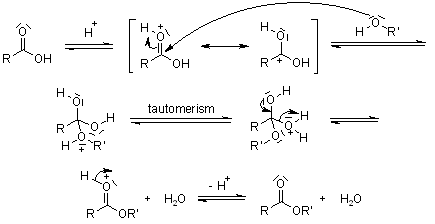
Addition of a proton (e.g.: p-TsOH, H2SO4) or a Lewis acid leads to a more reactive electrophile. Nucleophilic attack of the alcohol gives a tetrahedral intermediate in which there are two equivalent hydroxyl groups. One of these hydroxyl groups is eliminated after a proton shift (tautomerism) to give water and the ester.
Alternative reactions employ coupling reagents such as DCC (Steglich Esterification), preformed esters (transesterification), carboxylic acid chlorides or anhydrides (see overview). These reactions avoid the production of water. Another pathway for the production of esters is the formation of a carboxylate anion, which then reacts as a nucleophile with an electrophile (similar reactions can be found here). Esters may also be produced by oxidations, namely by the Baeyer-Villiger oxidation and oxidative esterifications.
|
